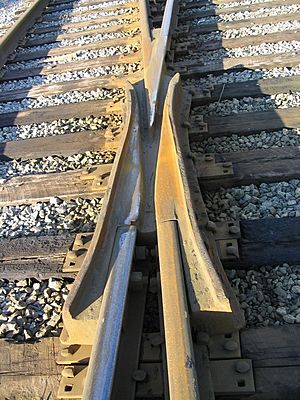Frog war facts for kids
A frog war was a big fight between different train companies. It happened when one company wanted to build tracks across another company's existing lines. These "wars" were named after a special part of the track called a frog. This "frog" allows two train tracks to cross or join each other.
Frog wars often started with legal battles. Companies would file lawsuits or ask government groups for help. But sometimes, things got more serious. Workers from different companies would face off. They would try to block each other's construction projects. They even used trains to stop the other company from building or moving.
Contents
Sharing Costs for Track Crossings
When a new train company wanted to cross an older company's tracks, they usually had to pay for it. This included the special tracks needed for the crossing. They also paid for any interlocking tower or signal box. These towers helped control the trains safely. Sometimes, the new company even got to control the signals. This meant their trains could go first through the crossing.
Oil Pipelines and Train Tracks
Long ago, most oil moved by train. Then, oil pipelines started to become common. Train companies saw these pipelines as a threat to their business. They often refused to let pipelines cross their train tracks. This led to more "frog war" type conflicts.
Bridges, Rivers, and Trains
Famous American leader Abraham Lincoln was part of an important court case. This case decided that train companies had the right to build bridges over rivers. This right was just as important as riverboats having the right to travel on those rivers. In Canada, a train bridge built in 1870 made the Shubenacadie Canal unusable.
Famous Frog Wars
Here are some examples of real "frog wars" that happened. The first train line listed was usually the one built first.
Frog Wars in the Netherlands
- 1845: A person who owned land did not like a train company. He bought a small road near Delft. He wanted to stop the Haarlem-Hague Railway from building there. He refused to sell his land or let them cross it. So, the train company had to build a very tight curve in their tracks to go around his property.
Frog Wars in the United States
- 1853: Two train companies, the Lake Shore & Michigan Southern Railway and the Illinois Central Railroad, had a big fight. They both tried to run trains through Grand Crossing in Chicago. They acted as if the other company's tracks were not there. This led to a terrible crash that killed 18 people.
- 1867: The South Carolina Railroad fought the Charlotte, Columbia and Augusta Railroad. They argued in court over a crossing in Columbia. One company even blocked the crossing with a parked train. Workers physically tore up tracks. Trains were even ready to move forward to block the crossing at any moment.
- 1870s: Three big companies, the Denver & Rio Grande Western Railroad, the Atchison, Topeka and Santa Fe Railway, and the Union Pacific Railroad, battled. They all wanted to build tracks through the best mountain passes in Colorado.
- January 1870: The Central Pacific Railroad tried to stop the California Pacific Railroad from entering Sacramento, California. But the Supreme Court of California said the California Pacific had the right to enter.
- December 2, 1870 – January 9, 1871: The Erie Railroad fought the Delaware, Lackawanna and Western Railroad's Boonton Branch. This happened near the Erie's Long Dock Tunnel in Jersey City, New Jersey.
- January 6 and 7, 1876: The Pennsylvania Railroad's Mercer & Somerset Railway fought the Reading Railroad's Delaware and Bound Brook Railroad. This battle took place in Hopewell, New Jersey.
- August 7 – September 13, 1883: The Southern Pacific Transportation Company battled the California Southern Railroad. This company was part of the Atchison, Topeka and Santa Fe Railway. The fight happened at Colton Crossing in Colton, California.
- March 1886: The Erie Railroad fought the New York Central Railroad's New Jersey Junction Railroad. This happened at King's Bluff near Weehawken, New Jersey.
- September 1891: The Central Railroad of New Jersey fought the Lehigh Valley Railroad's Jersey City, Newark and Western Railway. This conflict took place in southern Jersey City, New Jersey.
- March 1894: The Pennsylvania Railroad's Cape May and Millville Railroad fought the Reading Railroad's Tuckahoe and Cape May Railroad. This happened at Woodbine Junction, New Jersey.
- 1897: The Pennsylvania Railroad fought the Lehigh Valley Railroad's New Jersey Junction Connecting Railway in Jersey City, New Jersey.
- December 1897: The Pennsylvania Railroad fought the Newtown Electric Street Railway in Langhorne, Pennsylvania. This was not a typical "frog war" because tracks were not crossing. But the PRR still tried to stop the electric railway from building under their tracks. Passengers had to get off one trolley, walk through a tunnel, and get on another trolley.
Frog Wars in the United Kingdom
- Battle of Havant: This was a conflict between the London & South Western Railway and the London, Brighton & South Coast Railway. They fought over building a new train line to Portsmouth.
- Nickey Line: Another example of a railway conflict.
- A fight between the London, Brighton & South Coast Railway and the South Eastern Railway (England). They both wanted to reach Hastings and St Leonards. This happened near Bo Peep Junction.


